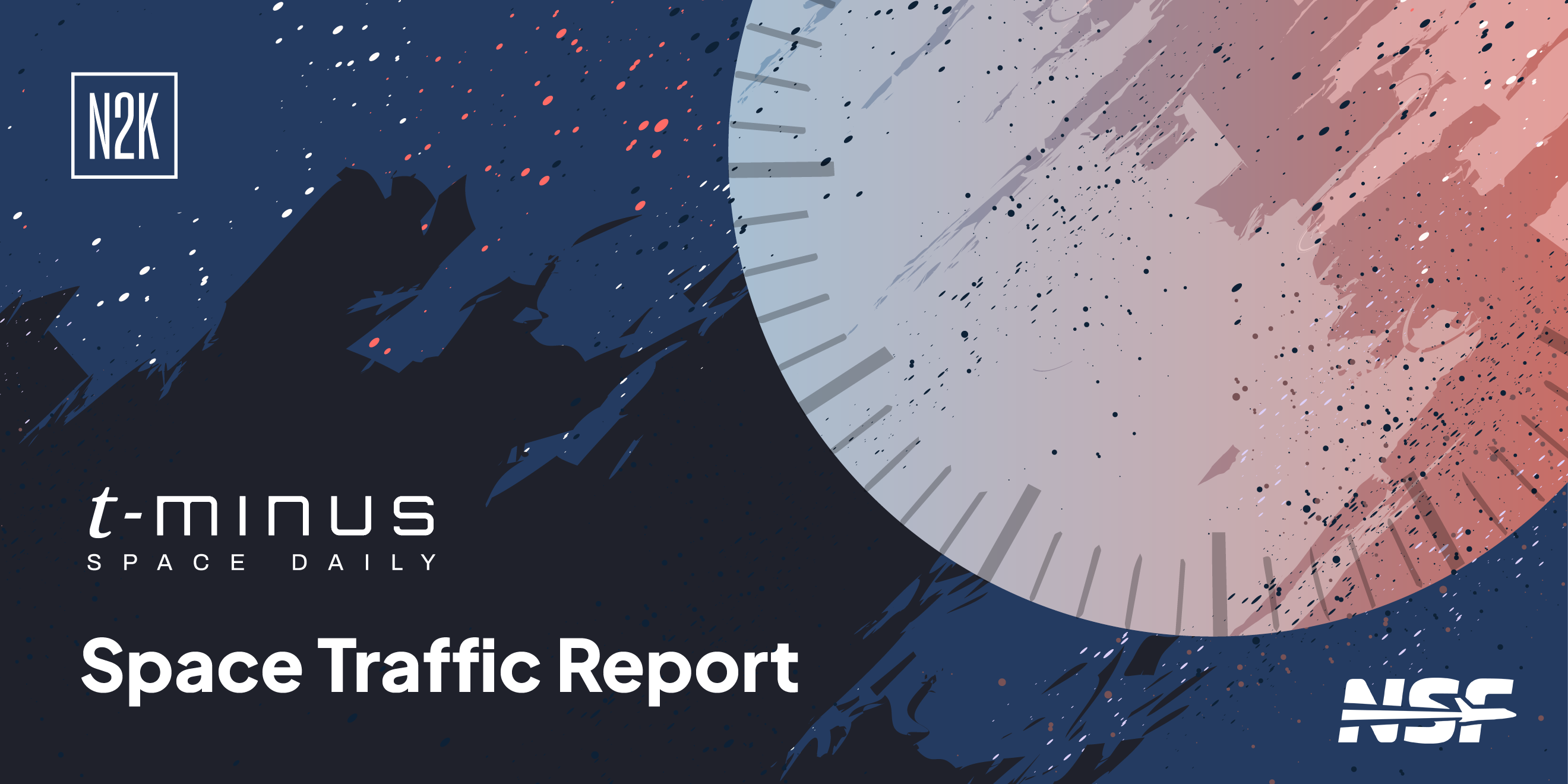[MUSIC] >> Yesterday, there was some hand-wringing, understandably, about the commercial successor to the ISS. Will Axiom Station be ready in time? What happens if the ISS is de-orbited? Would Tiangong truly be the only orbiting lab anymore? Well, maybe not if India has anything to say about it. >> There's only one clear winner in the Space Race, Maria. But don't worry, everyone will get a constellation prize. [LAUGHTER] >> The face you made, you knew that was the face you made. It's really sold out. [MUSIC] >> Today is September 20th, 2024. I'm Maria Varmazes. >> I'm Alice Carruth and this is T-minus. [MUSIC] >> India approves plans to expand the Gaganyan program. Interstellar Technologies receives $32.5 million from Japan's government. China launches the last pair of BDS-3 satellites. >> And it's Friday, so we have our weekly NSF Space Traffic report. LSS EGOR will be reviewing the space launch news from the week that's been on the agenda and looking ahead at the week to come. [MUSIC] >> Happy Friday, everybody. India's space program continues to grow at an astounding pace, with the Indian government approving several major new space initiatives that we'll all be following closely. Notably, one of these projects is for the first module of India's own space station, the Batarya Antarik Station, or BAS-1, with a planned launch of this unit by December 2028, with a target date of the station to become operational in 2035, just around when the ISS is hitting its end of life. So that's some good timing there, to be sure. And as if this news of a space station module isn't enough, India's government also approved funds for a new reusable launch vehicle, a lunar sample return mission, and a Venusian probe, all approved by the Indian government to the tune of $2.7 billion. Not too shabby. Indian Prime Minister, Narendra Modi, shared on X, great news for the space sector. The union cabinet has approved the first step toward the Batarya Antarik Station, expanding the Gaganjan program. This landmark decision brings us closer to a self-sustained space station by 2035, and a crewed lunar mission by 2040. Pretty cool stuff for India. Now, Japan's government has approved a small business innovation research program, Phase 3 grant for interstellar technologies, worth up to 4.63 billion yen. That's about $32.5 million in the US. Interstellar is a space infrastructure company dedicated to addressing global challenges through space transportation and utilization. The grant is administered by the Ministry of Education, Culture, Sports, Science and Technology to promote R&D and startups. Japan is aiming to advance sovereign access to space by supporting companies such as Interstellar. Interstellar says it's committed to advancing Japan's independent access to space through the development of a low-cost, high-frequency rocket designed for launching small satellites. The company also aims to establish a globally competitive space transportation system. And over to China now. And yesterday saw the country launch the last pair of backup satellites for the Beidou-3 navigation satellite system, also known as BDS-3. The satellites, which are the 59th and 60th in the family of Beidou, were transported into orbit by a Long March 3B rocket from the Xinjiang Satellite Launch Center in southwest China's Sichuan Province. Chinese media reports that the two medium-Earth orbit satellites will enhance the system's reliability and improve services of position, navigation and timing, as well as short message communication for global users. BDS-3 now operates a total of 30 networking satellites in orbit, most of which have been in service for six years. With most of these satellites designed for a lifespan of 10 years, researchers are planning an upgrade for the deployment of new satellites. The Soyuz MS-25 spacecraft is planning to depart the International Space Station on Monday to return to Earth. The spacecraft will be carrying NASA astronaut Tracey C. Dyson and Roscosmos cosmonauts Nikolai Chubb and Oleg Kononenko, which are expected to land in Kazakhstan at 5pm local on Monday, but not before the cosmonaut set a new record for the longest single space flight aboard the ISS today. At 4.06.51pm Moscow time, Kononenko and Chubb broke the record of Russian cosmonaut Sergei Prokofiev and Dmitry Petrelin and NASA astronaut Frank Rubio, who spent 370 days, 21 hours, 22 minutes and 16 seconds on board the ISS between September 2022 and September 2023. A change of command ceremony on the ISS where Kononenko will hand over station command to NASA astronaut Sonny Williams for Expedition 72 will be held on Sunday. It was Sonny's birthday yesterday, so we're sure the celebrations will continue throughout the weekend. We'll be bringing you updates on that mission next week. And happy birthday, Sonny! Luxembourg-based Mission Space has announced a partnership with DeFi Space. The collaboration aims to launch into orbit the first commercial payload dedicated to space weather monitoring. Mission Space plans to launch a satellite constellation aimed at delivering real-time, high-resolution data on space weather phenomena. The launch is set for the first quarter of 2025. She reported yesterday that Rocket Lab's Electron launch carrying payloads for Kines was aborted for unknown reasons. But Rocket Lab released soon after that that the launch was halted due to technical issues. The Electron rocket is now back on the pad with its payload of five satellites for Kines and is ready to launch this evening US time. Electron is due to launch from Rocket Lab's Launch Complex 1 in New Zealand. We'll bring you more on that fly on Monday's show. Iridium Communications Board of Directors has approved an additional $500 million for its share repurchase program, bringing the total authorization to $1.5 billion since its inception. Share repurchase programs allow companies to buy back their own stock from the market, typically to return value to shareholders, improve financial metrics, or signal confidence in future performance. Iridium began its share repurchase program in 2021 with the aim of maximizing return on investment for investors. NASA is taking steps to attract more diversity and create more inclusion in the fields of science, technology, engineering and math. NASA and the National Association for the Advancement of Colour People, better known as NAACP, signed a space act agreement to increase engagement and equity for underrepresented students pursuing STEM fields and to improve access to agency activities and opportunities. In addition, the US Agency is awarding $7.2 million to six minority-serving institutions to grow initiatives in engineering-related disciplines and fields for learners who have historically been underrepresented and underserved in STEM fields. And calling all New England innovators, or should I say innovators, the main space conference pitch competition is coming up October 23rd to 25th, and it is still accepting applications. The event offers the opportunity to showcase solutions that will advance Maine's space economy and potentially earn significant prizes. Details can be found by following the link in the selected reading section of our show notes. And as always, you'll find links to articles for further reading on all the stories mentioned in our show notes. We also included an announcement from BlackSky who've received an award at World Space Business Week in Paris. And hey, T-minus crew, tune in tomorrow for T-minus Deep Space. It's our show for extended interviews, special editions, and deep dives with some of the most influential professionals in the space industry. And tomorrow we have Maria Lannis talking about Project Postcard and the Space for Art Foundation. Check it out while you're enjoying the obligatory pumpkin-spiced fall festivities or just noting the equinox in whatever way feels right to you. You don't want to miss it. It is Friday, so that means it's time for the Space Traffic Report, brought to you by our partners at nasaspaceflight.com. Alicia Segal brings us a look at the space launch updates from the week that's been and a look ahead at the week to come. And I will be in Florida for crew nine. Come on, come on, come on. Wish you a thingy. I'm Alicia Segal for NSF, and this is your weekly Space Traffic Report for T-minus Space. Starting off the week, we had the return of Crew Dragon Resilience and its crew of four as the Polaris Dawn mission came to a close. The mission had kicked off the previous week on September 10th from Launch Complex 39A carrying into orbit Commander Jared Isaacman, pilot Scott Poteet, mission specialist Sara Gillis, and medical officer Anna Mennon. Over the following days, the crew completed a series of milestones, such as becoming the first humans to fly the furthest away from Earth since Apollo 17, testing Starlink's laser link connectivity, and performing the first all-commercial spacewalk using SpaceX's newest EVA suit. While all those milestones were being checked off, the crew was also rather busy performing 36 other different research experiments while in orbit. Most of those experiments were focused on further studying the human body and the conditions of microgravity, from muscle and bone loss to ID formation due to fluid shift. The crew also carried out tests on how to perform medical diagnostics and intervention in space using compact instrumentation that can detect pathologies and allow astronauts to medically intervene when needed while in space. Despite all of this busy work, the crew also still had some time for less scientific and more amusing activities like playing the violin while inside Dragon. Sara Gillis performed and recorded "Raze Theme" by John Williams on the violin while inside Dragon, which was later edited together with performances of many other musicians from around the world into one fantastic video, and then tweeted out via the Polaris Program account on X with the title "Harmony of Resilience." After the crew's return, they even explained that this violin had to go through vacuum testing specifically to be able to fly it in space and to make sure that it wouldn't outgas during the spacewalk that was scheduled for the mission. Sara also mentioned that the bow had to be shortened in order to be able to fit it inside as well, which made playing the violin much more complicated. Hopefully in the future, as human spaceflight becomes more commonplace, things like having enough room inside of the spacecraft won't be such an issue to bringing instruments up into orbit. With all of the research and milestones completed, the crew prepared for its return to Earth, which began with Dragon's trunk separating at 635 UTC on September 15. This was followed a few minutes later by a seven-minute-long de-orbit burn that put resilience on track to splash down off the coast of Florida. Now, if you remember back to when they originally wanted to launch this mission, SpaceX had encountered quite a bit of bad luck while looking for good weather in the usual splashdown sites for Crew Dragon. SpaceX in turn delayed the launch by a few weeks since Dragon isn't able to loiter in orbit for too long while waiting for clear skies down on Earth. The seven splashdown locations are spread between the Gulf of Mexico and the east coast of Florida, but after struggling to find a window of decent weather for those locations, SpaceX looked at other potential sites with weather that could support Polaris Dawn's return. Crew Dragon resilience successfully passed through reentry, popped out its drug and main parachutes, and splashed down at 736-54 UTC near the dry tortugas in Florida. NSF's Max Evans and DYs drove all the way out to Key West just to capture resilience's reentry and were able to successfully spot Dragon as it was coming down to Earth, with the moon nicely framed up in the background too. One of the other potential alternative sites that SpaceX had looked into for this mission was off the coast of Cape Coral, a splashdown site that would have been about 150 kilometers further north than the one that was eventually chosen. Within an hour of splashdown, the crew was out of the capsule and able to walk on their own. They all eventually flew back to the Kennedy Space Center, where they reunited with family and friends and were able to visit Launch Complex 39A again just a week after launching from it. So what's next for the Polaris program? Well, we know that the third mission will be the first crewed flight of Starship, but as for the second mission, we have no idea just yet. And we asked. We really asked. And from returns to orbit to launches into orbit, we had quite a peculiar one this week by none other than Iran. This week, the country launched its Ka-M100 rocket, which lived off on September 14th at 558 from the Sherwood Missile Test Site. The rocket was carrying the Chomrom-1 satellite into low Earth orbit. This is a small 60 kilogram mass satellite intended to test out in-orbit propulsion systems and was the fourth launch of the small rocket and third successful one overall. Next we go to the Plesets Cosmodrome in Russia, where there was a launch of an Angara 1.2 rocket. Lift-off took place on September 17th at 701 UTC, carrying two classified payloads for the Russian Ministry of Defense. The nature of these satellites is still unknown, but as is customary for Russian government launches, they've been labeled with the names "Cosmos 2577" and "Cosmos 2578" for the time being. All the way back in the U.S., we had the launch of a Falcon 9 rocket on September 17th at 2250 UTC from Space Launch Complex 40 in Florida. The mission was carrying two Galileo Global Positioning Satellites for the European Commission into a medium Earth orbit. This is the second pair of Galileo satellites to be launched on Falcon 9 following a previous launch that took place back in April. Back then, the booster had to be expended in order to be able to push the two satellites into their intended orbit. However, based on the data from that mission, SpaceX was able to tweak the rocket and its launch profile in order to optimize its performance and deliver these satellites into their intended orbit while also recovering the first stage. This would still be a challenging landing, however, as the booster had to stage faster than usual and come through the atmosphere at a higher velocity. This likely is why SpaceX chose to fly B-1067, which had already completed 21 missions prior to this one. If it was lost, at least it had already been used quite a few times. During the mission, we saw that, indeed, the booster shut down its nine engines during ascent at higher speeds than normal for a mission with booster recovery. While boosters normally stage at a speed of about 8,000 km/h during a normal Starlink mission, this flight saw the booster reach a peak speed of about 8,750 km/h. This translates into about 9% more speed and therefore about 20% more kinetic energy than usual that then needs to be scrubbed off during reentry. Despite this, the first stage was able to make it through reentry, and while the video signal was lost, it successfully touched down the deck of SpaceX's drone ship just read the instructions. The two Galileo satellites launching on Falcon 9 were not the only global navigation satellites launched into orbit this week. From China, a Changjiang 3BE, fitted with a Wangjiang 1 upper stage, lifted off on September 19 at 114 UTC from the Shichang Satellite Launch Center. The rocket was carrying the 59th and 60th satellites of Baidou, China's own global positioning system. The system consists of multiple satellites operating in medium and geosynchronous Earth orbits, with these two satellites being part of the newest set of Baidou 3 satellites placed in medium Earth orbit. And sometimes there are certain events in space that, unfortunately, end up happening between recording and when we publish, even though we'd try for that time to be as short as possible. This week in that timeframe there are at least three launches scheduled to go up, so we can't cover them all in detail just yet, but two of them are expected to launch from China with yet unknown payloads, while the other will be a launch of a Falcon 9 from Vandenberg with a batch of Starlink Direct-to-Sell and Starlink V2 mini-satellites. We'll be sure to cover them all in more detail on next week's Space Traffic Report. Also absent from this report is the launch of Rocket Lab's Electron rocket on the mission called "Kanace Killed the Radio Star," and that's because it actually ended up scrubbing. The mission had been scheduled to launch on September 18th at 2301 UTC and the rocket was pretty much ready to go, but as the countdown neared zero, the engines ignited and then abort. Electron did not take off that day, and according to Rocket Lab's CEO Peter Beck, this appears to be due to an issue with "a piece of ground support equipment not reaching its target in the allocated time." This issue is interesting given that this was the first launch from Pad A at Rocket Lab's launch complex in New Zealand since July of 2022. Maybe during that downtime, the company changed something in the ground systems that may not have behaved as it should during the attempt. However, this issue seems to have been minor as teams were able to quickly solve it, and Rocket Lab is now aiming to launch this mission again later today, September 20th, at 2301 UTC. Going into next week, we'll have another crew return, this time of the Soyuz MS-25 spacecraft and its crew of three. With the Soyuz MS-26 mission lifting off about a week and a half ago and docking to the International Space Station, it's now time for the previous Soyuz mission to return home. This will be preceded this weekend by a change of command ceremony in which Oleg Kononenko, Soyuz MS-25 spacecraft commander, will hand over command of the station to Sunita Williams. Yes, turns out he's currently both commander of the ISS and of his spacecraft. Undocking of the Soyuz spacecraft from the Prashal module is scheduled to take place on September 23rd at 837 UTC, followed less than four hours later with a touchdown on the steps of Kazakhstan at 12 o'clock UTC. If all goes well with the Falcon 9 launch from Vandenberg this Friday, SpaceX may quickly try another Starlink launch next week from there, potentially as soon as September 24th. The four-hour launch window that day would open around 2300 UTC. Right on the heels of Polaris Dawn's return, SpaceX is set to launch another crew dragon, this time with the next crew rotation mission to the ISS. SpaceX and NASA recently adjusted the dates for this mission, and it's now scheduled to launch no earlier than September 26th at 1805 UTC. The crew is scheduled to arrive at the Kennedy Space Center this Saturday to begin pre-launch preparations, including a dry dress rehearsal and a static fire test for this first crewed launch from Space Launch Complex 40. I'm Alicia Siegel for NSF, and that's your weekly Space Traffic Report. Now back to T-Minus Space. [Music] We'll be right back. [Music] Alright, welcome back. It has been a while since we've delved into the latest discovery from the Hubble Space Telescope, and we're big fans of it here, so it's time to rectify this oversight. The latest news comes from an international team of researchers led by scientists in the Department of Astronomy at Stockholm University, and they have found more black holes in the early universe than had previously been reported, all thanks to information captured by none other than Hubble. Scientists do not have a complete picture of how the first black holes formed, but it is known that supermassive black holes, which can weigh more than a billion suns, exist at the center of several galaxies less than a billion years after the Big Bang. That's relatively new in universe time. New observational results suggest that some black holes likely formed by the collapse of massive, pristine stars during the first billion years of cosmic time. And these types of stars can only exist at very early times in the universe, because later generations of stars are polluted by the remnants of stars that have already lived and died. Other alternative suggestions for black hole formation include collapsing gas clouds, mergers of stars in massive clusters, and primordial black holes that formed by physically speculative mechanisms in the first few seconds after the Big Bang. The new information can help scientists understand how supermassive black holes were created, and will help form more accurate models of galaxy formation. Everybody loves a black hole story. That's it for Team Ioners for today, September 20th, 2024, brought to you by N2K Cyberwire For additional resources from today's report, check out our show notes at space.n2k.com. We'd love to know what you think of our podcast. Your feedback ensures we deliver the insights that keep you a step ahead in the rapidly changing space industry. If you like our show and we do hope you do, please share a rating and review in your podcast app. Please also fill out the survey in the show notes or send an email to space@n2k.com. We are privileged that N2K Cyberwire is part of the daily routine of the most influential leaders and operators in the public and private sector, from the Fortune 500 to many of the world's preeminent intelligence and law enforcement agencies. N2K makes it easy for companies to optimize your biggest investment, your people. We make you smarter about your teams while making your teams smarter. Learn how at n2k.com. This episode was produced by Alice Carruth. Our associate producer is Liz Stokes. We are mixed by Elliot Peltzman and Trey Hester, with original music by Elliot Peltzman. Our executive producer is Jennifer Iban. Our executive editor is Brandon Karpf. Simone Petrella is our president, Peter Kilpie is our publisher, and I'm your host, Maria Varmazes. Thanks for listening. Have a wonderful weekend. [Music] Team. [Music] [BLANK_AUDIO]









